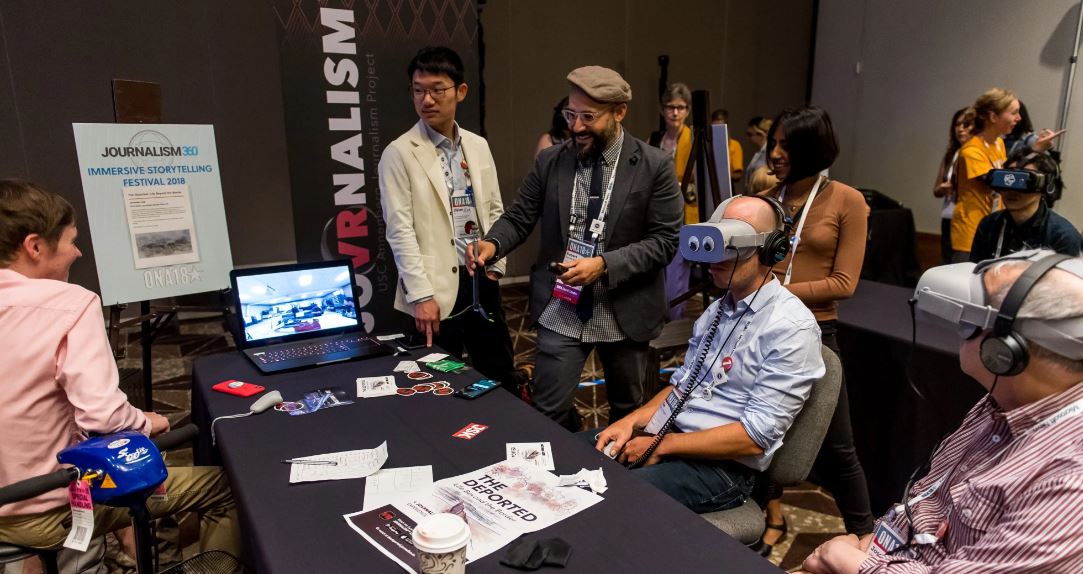Since 2003, more than 2,000 newspapers across the U.S. have closed, leaving some communities without a reliable source of local news[1].
Due to a plethora of digital information sources, subscriptions for print journalism have drastically declined. More people today are consuming news and information through social networks rather than traditional media.
Digital storytelling with immersive technology is the new frontier for gaining new audiences while growing the next generation of accurate and objective journalism.
In fact, immersive technology is reshaping the next generation of journalism talent – and their ability to put their audiences at the center of stories to separate fact from fiction.
Journalism students are learning how to produce immersive media including interactive news, integrating virtual, augmented and extended reality as well as 360 videos, animated graphics, and short-film digital videos in the production of documentaries and news programs.[2]
I recently toured ASU’s media center in Los Angeles. I met world-class frontrunners in immersive media, who are using their research to revolutionize journalism and shape the careers of future storytellers.
Among these was Nonny de la Peña, who produced the world’s VR documentary in 2012, Hunger in Los Angeles’ showcased at the Sundance Film Festival. The documentary created empathetic viewership as issues of homelessness, hunger and living on the streets were spotlighted using real human voices with video simulation.
In my book, Leadership in the Metaverse, I discuss three leadership qualities needed as the metaverse evolves – the agile, strategic leader, the authentic leader, and the servant leader-community builder.
Strategic and agile
Leaders can enhance their ability to be both agile and strategic, using immersive media to visually communicate an organization’s vision, purpose and direction.
To get started, hire digital content creators to help you develop visual stories to describe your organization’s strategies and major initiatives. Share visual experiences with your employees, clients, and other key constituents to create opportunities for engagement.
Authentic
You can use immersive media to create authentic experiences, allowing your stakeholders to see and feel the reality of a situation firsthand.
For example, de la Peña created a VR experience in 2019, allowing viewers to walk around a prison cell and experience the reality of solitary confinement. Immersive experiences could be useful for policymakers.
Community building servant leaders
Immersive technology has the power to bring people together in physical and digital worlds, bridging cultures and communities and new resources that otherwise might not have been discovered.
Physically, we cannot be in multiple places at the same time! But virtual reality allows us to travel to infinite places and experience situations firsthand.
Within an hour, you could experience sights, sounds and sensations of very different realities – from climbing Mount Everest to walking through a museum – all within the comfort of your home. This puts you in the middle of the situation, rather than reading about it or watching it on TV.
Best yet, VR will provide the opportunity to make situations more accessible and inclusive. For organizations, engagement in an organization’s strategy enhances participation.
Also at ASU, college business students are gaining real-life negotiation skills during tense, high-stakes boardroom meetings simulated through virtual reality (VR).[3]
As leaders use immersive media techniques, they are likely to grow skills in strategy, agility, authenticity and building community through creating shared experiences.
[1] PBS News Hour, Aug. 2, 2023. How the loss of local newspapers fueled political divisions in the U.S. https://www.pbs.org/newshour/show/how-the-loss-of-local-newspapers-fueled-political-divisions-in-the-us#:~:text=Over%20the%20past%20few%20decades,fueling%20the%20country’s%20political%20divisions.
[2] At Arizona State University’s California Center based in Los Angeles featuring ASU’s Walker Cronkite School of Journalism and Mass Communication.
[3] At Arizona State University’s W.P. Carey School of Business.
Photo source: Online News Association; https://journalists.org/2018/11/14/the-resources-you-need-to-get-started-with-immersive-journalism/




